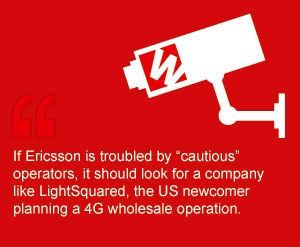Green light fingered
Everyone wants to be green, right? It’s a positive thing. Good ideas get the green light. Green is verdant, fertile and lush. Green is vigorous. Green is environmentally friendly. Green is also envious and gullible. While mobile phone recycling schemes have made much of their positive green credentials, they have also had negative influences, certainly here in the UK. Mobile phones stolen in the UK are almost always deactivated shortly after their theft, meaning that they can’t be used on any UK network.
July 23, 2010

By The Informer
Everyone wants to be green, right? It’s a positive thing. Good ideas get the green light. Green is verdant, fertile and lush. Green is vigorous. Green is environmentally friendly.
Green is also envious and gullible.
While mobile phone recycling schemes have made much of their positive green credentials, they have also had negative influences, certainly here in the UK. Mobile phones stolen in the UK are almost always deactivated shortly after their theft, meaning that they can’t be used on any UK network.
But recycling schemes ship large quantities of the handsets they receive overseas to markets where the blocks on the phones do not have effect. These schemes can also pay pretty good money for consumers’ old phones. The result? The ever inventive criminal underclass of this green and sceptred isle quickly realised that the phones they steal can be sold to recycling firms that then make a profit by effectively fencing them on to other countries, often developing ones.
Not that they have been doing this wittingly, of course. They can’t help it if people steal phones—and you don’t have to prove you bought the phone when you send it off to them. It may never even have occurred to some of them that they were, in some cases, receiving stolen goods. They’re just a bit green.
Anyway, a new national database in the UK should make it more difficult for the thieves to continue to profit. The vast majority of UK handset recycling firms have signed up to a new scheme whereby they must check all received phones against a database of those that have been stolen. Any that match have to be handed in, and the thieves receive no bounty.
Speaking of bounty there was a wave of Q2 results this week, with the usual round of winners and losers. But when it comes to results, sometimes even the winners don’t get cheered. Ericsson turned in profit for the quarter that was more than double what it achieved for the same period in 2009, but still saw its share price drop because it fell short of analyst expectations (something it had already warned would happen).
The firm bagged SEK2bn (US$274m) for the three months to end June this year, compared to SEK800m last year. Group sales were down eight per cent at SEK48bn, with network sales down 12 per cent at SEK25.5bn. Global services revenues were flat at SEK20bn, although the professional services unit, which includes the firm’s managed services activities, saw sales increase five per cent to SEK14.8bn.
Managed services, that’s where it’s at, and that’s where Ericsson has carved itself a decent leadership over its rivals, especially China’s Huawei. As if to rub this in, Ericsson this week the firm announced a deal with China Mobile that will see it take on responsibility for the field maintenance of 22,000 GSM/TD-SCDMA base station sites in the Hebei province in Northern China. This sub-division of China Mobile is only a tiddler, with a handful of customers – 35 million, to be exact. The deal is good for three years and Ericsson has already started work on it.
In Spain, meanwhile, Ericsson – together with local IT services provider Indra – has taken control of incumbent carrier Telefónica’s prepaid billing assets and operations. Some 500 staff will move from carrier to the vendor partnership, 400 from the mother country and 100 from Brazil. The carrier has also inked a seven-year deal with the two suppliers to manage prepaid services across more than 20 of its operations.
Back at the results, though, CEO Hans Vestberg characterised carrier spending as “mixed” and “cautious”, although he claimed they showed enthusiasm for mobile broadband investment on the back of the well documented growth in data usage. Ericsson’s high profile cost reduction programme has been completed, he said, with OPEX targets met. Unfortunately for Ericsson, OPEX was up during Q2, due to the integration of the Nortel assets the firm bought last year, increased R&D and growth in LTE trials.
Finland’s Nokia group would probably settle quite happily for a drop in share price on the back of a doubling in profit. Alas that was not the story it was telling this week. Instead the firm was forced to report that net profit for the quarter was down a whopping 63 per cent year on year at €1034m.
CEO Olli-Pekka Kallasvuo put a brave face on things, saying: “Despite facing continuing competitive challenges, we ended the second quarter with several reasons to be optimistic about our future.” It was a particularly brave face given the reports that Nokia has been combing the world for his replacement, having lost faith in Kallasvuo’s ability to plug the hole’s in Nokia’s leaking hull.
Net sales in the firm’s devices and services division were up three per cent at €6.8bn, year on year. Operating profit for the division was down 31 per cent to €295m, however, and the operating margin also tumbled to 9.5 per cent from 11.6 per cent.
Nokia said the net sales increase was the result of “higher volumes in most regions driven by stronger demand, partially offset by an ASP decline, compared to the second quarter 2009”. But the firm reiterated that it had been hit by intense competition in the high end, where it has endured well documented struggles for some time.
And that high end is only going to get more important, with Strategy Analytics this week reporting that global smartphone shipments grew 43 per cent year on year to 60 million units in Q2. The firm said this accounted for 19 per cent of handset volume, and was driven by that competition that’s doing for Nokia as well as enthusiastic subsidies from operators and “lower-cost models using operating software like Symbian and Android.”
Competition is only going to get worse, said Neil Mawston, director at the analysis firm. “Dozens of vendors form the telecoms, PC and consumer electronics industries are piling into the market and driving down prices,” he said. Boy, oh boy, does Nokia have its work cut out.
It was a good week for Nokia Group to focus on its infrastructure arm, so that’s what it did. If Ericsson is troubled by “cautious” operators, it should look for a company like LightSquared, the US newcomer planning a 4G wholesale operation. LightSqaured said this week that it has given Nokia Siemens Networks a $7bn contract to deploy infrastructure for its LTE/satellite combination network.
Backed by Harbinger Capital Partners and incorporating US satellite operator SkyTerra Communications, LightSquared aims to offer wireless broadband capacity to retailers, wireline and wireless service providers, cable operators, device manufacturers, web players, content providers, and pretty much anyone who wants it.
The firm will offer terrestrial-only, satellite-only, or integrated satellite-terrestrial coverage, will not offer a retail service and will not compete with its customers. Is it the operator of the future?
Sanjiv Ahuja, the onetime head of France Teleom’s Orange mobile operation, is in place as chairman and CEO, although it is not clear whether he will be balancing this role with his emerging markets startup, Augere. Ahuja will be joined by Frank Boulben, head of strategy, marketing, and partner development and previously group commercial director at Vodafone and group chief marketing officer at Orange; Drew Caplan, formerly SkyTerra’s chief network officer, will continue to serve in this capacity for LightSquared.
The company is anticipating commercial launch in the second half of 2011 and has said it will cover at least 100 million Americans by December 31, 2012; 145 million by the end of 2013; and 288 million by the end of 2015. In addition to the $2.9bn of assets already contributed by Harbinger, LightSquared this week announced additional debt and equity financing of up to $1.75bn.
And this wasn’t he only deal that Nokia Siemens was doing in the US this week, with the firm making prophets out of rumourmongers and announcing its purchase of Motorola’s infrastructure unit for $1.2bn.
NSN gave the impression of being far more interested in the relationships that come with the unit than with the assets themselves, suggesting that it would gain relationships with 50 new carriers, as well as improving some that are already in place. After all, Motorola’s focus on WiMAX and CDMA isn’t looking much like a long-term bet at the moment. And as carriers on those two technology paths look to evolve to LTE, increasingly likely despite the protestations of the WiMAX Forum, NSN hopes to be holding the door open for them.
Geographically, NSN said it expected the main benefits to come in the US and Japan, where it has not previously had a particularly strong position. China Mobile, Clearwire, KDDI, Sprint, Verizon Wireless and Vodafone were all name-checked by NSN as organisations with which its relationship would deepen as a result of the purchase. Some 7,500 Motorola employees are expected to move to NSN as part of the deal, including staff at large R&D sites in the US, China and India.
Julian Bright, senior analyst at Informa said that, while the deal made sense in light of NSN’s need to be more aggressive in the market, it would likely bring with it fresh challenges. “NSN struggled with the original merger of the two companies and the integration with Motorola will probably add to its woes,” Bright said. “The new entity represents a tough mix of nationalities, with the combination of US, German and Finnish cultures. While there are opportunities for the merger to enable the creation of more integrated solutions such as Single RAN, NSN first needs to overcome the problems associated with integrating a new vendor’s RAN equipment with its own existing core network, backhaul, network and subscriber management products.”
Just as this week’s edition of AWIW was going to press, reports began to circulate that NSN had ended its TD-LTE development project with Huawei. If this is true it’s interesting given the fact that came out this week that Motorola is suing Huawei for the alleged theft of trade secrets. Which itself is interesting given that Huawei was in the running to buy the Motorola assets snapped up by Nokia Siemens.
In a suit filed on July 16th, Motorola is alleging that one of its engineers shared confidential information about various elements of its technology directly with Huawei founder Ren Zhengfei, through IP networking firm Lemko, headquartered like Motorola in Schaumberg, Illinois. Lemko has a reseller agreement with Huawei. The legal action follows a suit from 2008 in which Motorola sued five former employees for sharing information with Lemko
Huawei described the lawsuit as “baseless”. In an emailed statement, Huawei said its only relationship with Lemko is as a reseller, an arrangement it has previously had with Motorola.
“Huawei, which in the past has had an agreement with Motorola allowing that company to resell Huawei’s wireless equipment, has only recently learned of the amended Motorola complaint,” the Chinese firm said. “The complaint is groundless and utterly without merit.�”
The statement continued: “Huawei will vigorously defend itself against baseless allegations. Moreover, as an active and significant player in global standards-setting bodies, Huawei has great respect for the rights of intellectual property holders, and will with equal vigour protect its own hard-earned intellectual property rights.”
And as we saw earlier, vigour is green.
Take care
The Informer
Read more about:
DiscussionYou May Also Like








.png?width=300&auto=webp&quality=80&disable=upscale)


_1.jpg?width=300&auto=webp&quality=80&disable=upscale)